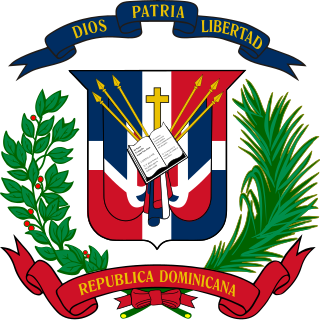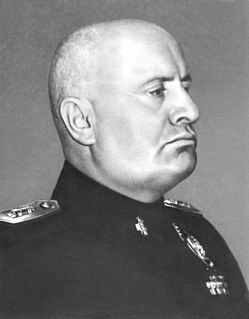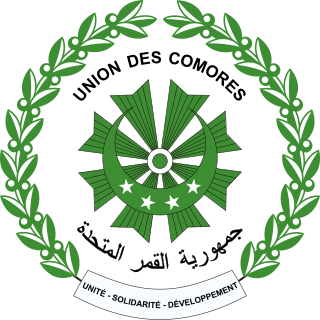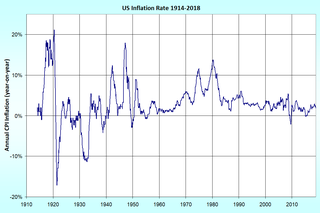
The Dominican Republic is a representative democracy, where the President of the Dominican Republic functions as both the head of the government and head of the multi-party system. Executive power is exercised by the government. Legislative power is vested in the bicameral National Congress. The Judiciary is independent of the executive and the legislature.
A constitutional amendment is a modification of the constitution of a polity, organization or other type of entity. Amendments are often interwoven into the relevant sections of an existing constitution, directly altering the text. Conversely, they can be appended to the constitution as supplemental additions (codicils), thus changing the frame of government without altering the existing text of the document.

This is a list of United States territorial acquisitions and conquests, beginning with American independence. Note that this list primarily concerns land the United States of America acquired from other nation-states. Early American expansion was tied to a national concept of manifest destiny.
Samaná Bay is a bay in the eastern Dominican Republic. The Yuna River flows into Samaná Bay, and it is located south of the town and peninsula of Samaná.

A referendum on the enlargement of the EC was held in France on 23 April 1972. Voters were asked whether they approved of Denmark, Ireland, Norway and the United Kingdom joining the EC.. The proposals were approved by 68.3% of voters, with a turnout of 60.2%.

General elections were held in Italy on 26 March 1934. At the time, the country was a single-party state with the National Fascist Party (PNF) as the only legally permitted party.

An independence referendum was held in the Comoros on 22 December 1974. The overall result was a strong "yes" vote, with 94.57% of voters voting for independence and almost all the "no" votes being cast in Mayotte, where there was a majority for remaining under French control. In contrast, on Mohéli only five out of 6,059 votes were against independence. Voter turnout was 93.3%.

The Annexation of Santo Domingo was an attempted treaty during the later Reconstruction Era, initiated by United States President Ulysses S. Grant in 1869, to annex "Santo Domingo" as a United States territory, with the promise of eventual statehood. President Grant feared some European power would take the island in violation of the Monroe Doctrine. He privately thought annexation would be a safety valve for African Americans who were suffering persecution in the US, but he did not include this in his official messages. Grant speculated that the acquisition of Santo Domingo would help bring about the end of slavery in Cuba and elsewhere. Militarily he wanted a US naval port in the Dominican Republic which would also serve as protection for a projected canal across Nicaragua.
The 1993 Brazilian constitutional referendum was held on April 21, 1993 to determine the form of government of the country. After the re-democratization of Brazil, an article in the new Constitution determined the holding of a referendum for voters to decide if the country should have a republican or a monarchical form of Government, and if the system of Government should be that of a presidential Executive or that of parliamentary government.

A referendum on transferring ownership to the United States was held on 9 January 1868 on the islands of Sankt Jan and Sankt Thomas, two of three main islands in the Danish West Indies. In the referendum, held by universal male suffrage, voters could approve or reject the outcome of negotiations for the sale of the two islands to the United States for US$7.5 million. The third island, Sankt Croix, was to be sold separately to the US at a later date.

An unofficial referendum on the sale of the islands to the United States was held in the Danish West Indies on 17 August 1916. The proposal was approved by 99.83% of voters, with only seven people voting against. It followed the Treaty of the Danish West Indies, which was signed on 4 August, and also approved by a referendum in Denmark in December 1916. The islands were transferred to the United States in 1917.

A referendum on annexation by the United States was held in the Dominican Republic on 19 February 1870. The proposal was approved by 99.93% of voters, although turnout was just 30%. However, the United States Senate rejected the annexation on 30 June 1870 with a 28–28 vote.

A constitutional referendum was held in the Federated States of Micronesia on 27 August 2002. Voters were asked whether they approved of 14 separate amendments to the country's constitution. To be approved, the proposal required at least 75% of voters in at least three of the four states to vote in favour. Ultimately all 14 proposals were rejected, as none passed the 75% threshold in any state.
A referendum is a direct vote in which an entire electorate is asked to either accept or reject a particular proposal. This article summarises referendum laws and practice in various countries.

A four-part referendum on arbitration over a border dispute with Haiti was held in the Dominican Republic on 2 June 1895. Voters were asked whether an arbitration tribunal should be established, whether the Pope would be an appropriate arbitrator, what compensation Haiti should receive if the outcome was favourable to the Dominican Republic, and whether the government should comply with the tribunal outcome if it was unfavourable to the Dominican Republic. All four proposals were approved by voters.

The Six Years' War (1868–74) was a civil war in the Dominican Republic that "constituted the third war of independence fought by the Dominican people", in this case against the administration of President Buenaventura Báez, which in 1869 negotiated the Dominican Republic's annexation to the United States. According to the Dominican intellectual Pedro Henríquez Ureña, this war was a critical phase in the creation of Dominican national consciousness because, having already differentiated themselves from the Haitians in the first war of independence and the Spaniards in the second, the Dominicans asserted their incompatibility with the United States.

A referendum on banning politicians and civil servants from having bank accounts or companies based in tax havens was held in Ecuador on 19 February 2017, alongside general elections. The proposal was approved by voters, giving officials one year to transfer their assets. If they do not, they will be removed from their posts.

A referendum on anti-corruption measures was held in Colombia on 26 August 2018. Voters were asked whether they approve of seven proposals aimed at reducing corruption: limiting the number of terms for politicians at all levels to three; requiring election candidates disclose their assets and those of their relatives; elected politicians being required to disclose their activities and private interests; a requirement for public hearings on budgets; a requirement for all public sector contracts to go out to tender; the removal of the right to parole for people convicted of corruption; and reducing the maximum salary of public officials and politicians from forty times the minimum wage to twenty-five times.

















